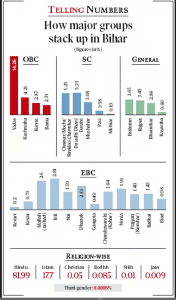Table of Contents
CONTEXT: The Bihar government has recently released the results of its recently concluded survey of castes in the state.
KEY FINDINGS OF THE SURVEY
• The survey puts the share of Extremely Backward Classes (EBCs) and Other Backward Classes (OBCs) cumulatively at more than 63% (EBC :36.01% and OBC: 27.12%). The “unreserved” category of so-called “forward” castes is about 15.52% and scheduled castes 19.65% and Scheduled Tribes (STs) are (1.68%).
• Bihar’s population, according to the survey, is 13.07 crore compared to the 10.41 crore recorded in the 2011 census. Hindus comprise 81.99% of the population, and Muslims 17.72%. The populations of Buddhists, Christians, Sikhs, Jains, and other religious denominations are minuscule.
WHAT IS A CASTE CENSUS?
• Caste census means inclusion of caste-wise tabulation of India’s population in the Census exercise.
• India has counted and published caste data from 1951 to 2011of the Scheduled Castes and Scheduled Tribes only. It also publishes data related to religions, languages and socio economic status.
• The Ministry of Rural Development Government of India, commenced the Socio Economic and Caste Census (SECC) 2011, in June 2011 through a comprehensive door to door enumeration across the country.
• However, SECC 2011 did not publish the caste data. The SECC data excluding caste data was finalized and published in 2016.
SIGNIFICANCE OF THE CASTE SURVEY:
• Identity Politics: Caste survey can enforce Identity politics as it will become easier to resonate with vote bank politics. Party campaign tends to play upon fixed identities and harnessing the ides of shared ideas and shared concerns. Also, in the case of Bihar unified EBC leadership may receive a new fillip. Similarly, Political coalition will get shaped and reshaped.
• Amplify calls for enumeration outside state:Bihar’s caste survey will also amplify calls for enumeration outside the stateand even on nationwide.This comes amid submission of Justice G Rohini Commission report.
• Inclusive growth: Caste based survey can acts as equalizing forces. With the help of caste numbers an informed public decision making can be done with at the same time giving aspiration and freedom of opportunity to marginalized sections. The survey has not only considered one’s caste but also one’s economic status, which would help us devise further policies and plans for the development of all classes.”
• Renewed demand for reservation: It may create opportunity for renewed backward class mobilization and can amplify demand for OBC quota beyond 27%. The survey data will also reopen the longstanding debate over the 50% ceiling on reservation imposed by the Supreme Court in its landmark ruling in Indra Sawhney v Union of India (1992).
ISSUES INVOLVED:
• Not holistic image: The survey may not capture the holistic image of the dynamic changes which may lead to inaccurate representations of reality. The dynamic changes may include intra caste variation and associated historical changes that fail to take into account contemporary changes.
• Political Manipulation: Caste-based data can beexploited by politicians for short-term gainsleading to vote bank politics. This can divert attention from genuine policy issues and can led to division in society.
• Stigmatization of marginalized groups: Disclosure of caste identities could lead to individuals being stigmatized or discriminated against based on preconceived notions associated with certain castes.
• Census under the union list:Census is conducted under the provisions of the Census Act, 1948.According to the constitution, Census is aUnion subject under list I, entry 69, schedule 7. Thus, it is held that it empowers only the central government to conduct census. Hence, by conducting the survey the state is violating the constitutional provisions according to critics.
WAY FORWARD:
• Balanced approach: There is a need of balanced approach for conducting a caste-based survey with establishing a clear ethical framework with informed consent that prioritizes privacy and dignity of citizens.
• Awareness campaigns: Public awareness campaigns with regular reviews and capacity-building initiatives can contribute to a long-term vision of conducting census with aim of reducing inequalities and fostering social integration.
• Uphold democratic principles: The census data should not become a weapon for increasing polarization to win elections and there is need to uphold democracy and the enhance the notion of representative democracy.
• Undoing historical injustice: Caste census data can be used as an instrument to address historically embedded backward and inequality and it can provide government opportunity for social justice.
CONCLUSION: There is no doubt that the publication of the Bihar caste survey results is an important moment in national politics. However, data must be handled with care and should not lead to shrinking of the very notion of representation in a large and diverse democracy.
SOURCE: https://indianexpress.com/article/opinion/editorials/bihar-caste-survey-a-welcome-step-8965726/
PREVIOUS YEAR QUESTION
1. How do you explain the statistics that show that the sex ratio in Tribes in India is more favourable to women than the sex ratio among Scheduled Castes? (2015)
2. Though there have been several different estimates of poverty in India, all indicate reduction in poverty levels over time. Do you agree? Critically examine with reference to urban and rural poverty indicators. (2015)
MAINS PRACTICE QUESTIONS
1. How can Caste based Survey help policymakers design and implement more effective policies to reduce socio-economic inequalities? Comment.
2. How Caste based Census can shape the identity politics in the country at regional and national level? Explain.



Related posts
TIPPING POINT: ON THE GST AND REFORMS
IN AN UNCERTAIN WORLD, INDIA’S TRADE PUSH
UNDERSTANDING THE INDIAN OCEAN’S LOCAL IMPACT